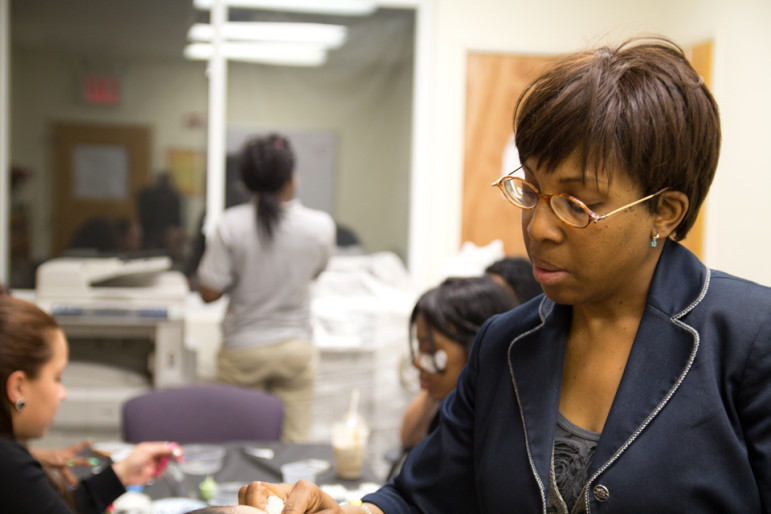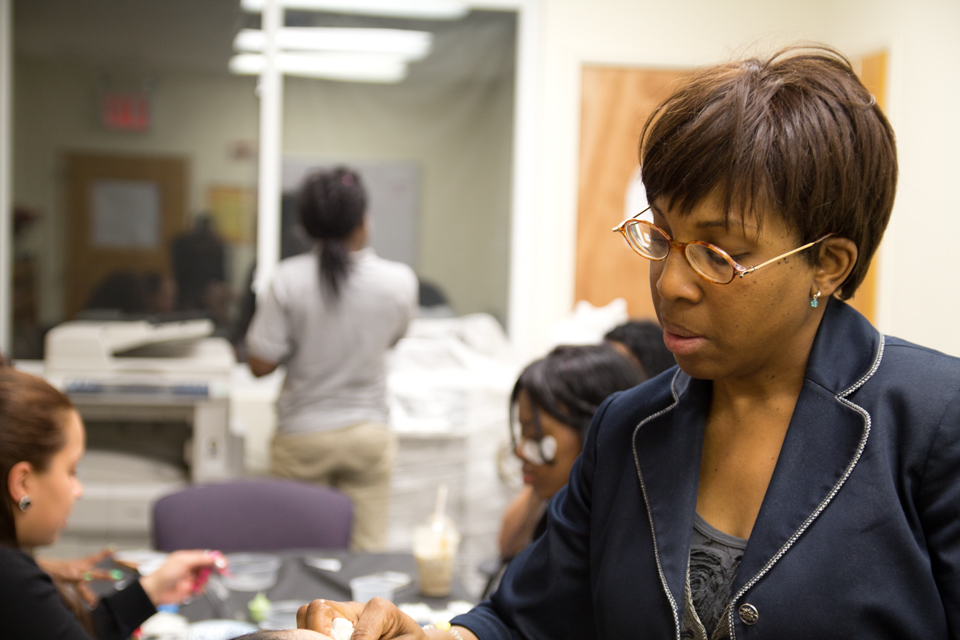
Mikhael Simmonds / The New York Metro Bureau / JJIE
Tara Brown, Bronx Connect ATD director, joins the teens in applying makeup. The program she runs helps juvenile delinquents gain the education, skills and self-esteem needed to integrate into life outside the juvenile justice system.
NEW YORK--Ramírez, 13, was brought into Brooklyn’s family court late Friday evening. Her case was the last case of the day. She was facing a third-degree assault charge and ordered to return to court the following week. She was detained overnight at a city juvenile detention center.
Ramírez is one of thousands of teens who pass through New York City’s juvenile justice system every year. This system costs the city and state billions of dollars annually. The city spends more money to detain or incarcerate a teenager per year than it spends on education. Even with recent attempts by the city to lower its juvenile justice bill, advocates familiar with the system still think the financial costs on the city and young people’s families are too high.
One program that lobbies for reduced juvenile incarceration is the faith-based Bronx organization Urban Youth Alliance International. The organization specializes in providing mentorship and academic programs to teens who would have otherwise gone to a detention center.
Rev. Wendy Calderon Payne, the group’s executive director, said the city and state pay too much to incarcerate, detain and rehabilitate New York City’s juvenile delinquents.
 “It’s a little ridiculous that we spend more to detain a youth for 12 months than you do on the educational system.”
“It’s a little ridiculous that we spend more to detain a youth for 12 months than you do on the educational system.”
Calderon Payne said the Alliance’s program for incarcerated youth is cheaper for the city. The alliance’s eight- to 10-month program costs about $6,200 per youth – less than a quarter of what the state pays to incarcerate a teen for a year.
In 2010, New York State spent $266,000 on each incarcerated young adult, according to the Office of Children and Family Services (OCFS), the state agency overseeing adoptions, abandonment and juvenile justice. In comparison, New York City’s Department of Education spent on average $18,500 per student that same year. That’s a ratio of about 14 to one.
Jeffrey Butts, director of the Research and Evaluation Center at John Jay College of Criminal Justice, said the increased security precautions, health treatments and rehabilitation programs in juvenile centers all contribute to the high costs.
“It’s hard to do a cross reference. It doesn’t mean you just can put them in school. That wouldn’t work,” he said.
Hiring qualified staff to work directly with the teens’ rehabilitation process is another reason incarceration costs are so high, according to Edward J. Loughran, executive director of the Council of Juvenile Correctional Administrators, a non-profit organization that works to improve juvenile correctional services.
“The driver of the cost of the facility is the personnel,” Loughran said. “Clinical staff and education staff get higher salaries if they have higher degrees.”
Many detention and incarceration facilities have education and rehabilitation programs. According to a New York State Juvenile Justice Advisory Group report, thousands of dollars can be spent on an individual throughout their detention. For example, treatment for juvenile sex offenders can run up to $33,842 annually.
Despite the thousands of dollars spent on these programs, basic needs for detained teens often go unmet, advocates say. Those costs are passed on to parents.
“They may have to pay for some very import essentials that some facilities do not provide, like underwear, socks, different things like that,” said Rukia Lumumba, the director of youth service at the Center for Community Alternatives. The organization is an alternative to detention program in downtown Brooklyn.
“In some facilities they get two meals a day. So unless your family sends care packages for you they don’t have additional food to eat,” Lumumba said. Parents also send underwear and other toiletries.
Many parents also have to miss work to attend court hearings or visit their children.
“It’s a significant cost,” Lumumba said. “Some parents have lost their jobs actually because they have to go to so many different appointments for their child’s criminal involvement.”
In an attempt to reign in the cost of incarcerating juvenile delinquents, New York City and the state are ending its practice of detaining youth upstate. The initiative, called Close to Home, focuses on keeping New York City youth closer to their own neighborhoods and families.
The city has also transferred responsibility for housing these teens from OCFS, a state agency, to the city run Administration for Children’s Service (ACS). This change has effectively downsized the program. The move is expected to save the city $36 million a year, according to OCFS spokeswoman Jennifer Givner.
Lumumba, who works closely with the juvenile justice system, doubts the initiative will make much of a difference in lowering the overall costs of the system.
“We need to invest more into alternative programs,” Lumumba said. “We want to make sure that our detention facilities are the smallest portion where funds are going and that the larger funding goes toward creating community-based alternatives.”
